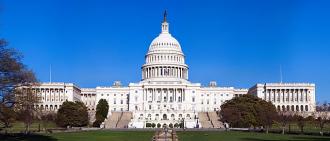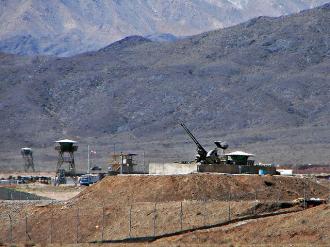The nation’s automakers would manufacture only electric cars. Utilities would have to stop producing pollution linked to climate change. And the federal government would double its investment in mass transit.
All this and more is being proposed by House Democrats on Tuesday under a plan aimed at bringing the U.S. economy’s greenhouse gas emissions – including carbon dioxide and methane – to zero by 2050.
House Speaker Nancy Pelosi, D-Calif., and Rep. Kathy Castor, D-Fla., will release an ambitious package of climate proposals that call for a combination of government mandates, tax incentives and new infrastructure.
The proposals would mandate electric utilities be net-zero emitters of greenhouse gases by 2040 and automakers produce only electric cars by 2035. The 538-page plan also backs placing a price on carbon emissions, imposing tougher methane limits and boosting energy efficiency in buildings. Solar and wind tax credits would be extended through 2025, and the tax credit for electric vehicles would be expanded.
The package has little chance of becoming law as long as Republicans control the Senate and President Donald Trump occupies the White House, but Pelosi and Castor have put down a marker in the hopes that electoral victories by Democrats this year will change the political balance in Congress in 2021.
“We’re going to press ahead with everything we can do in the near term,” said Castor, the chair of the House Select Committee on the Climate Crisis. “But yes, it will provide a plan that can be taken off the shelf and adopted into law as soon as we are able to reconvene.”
Speaking on the steps of the Capitol Tuesday, Pelosi called the report a “bold step for climate action now.”
“I wish it weren’t a fight,” she said, referring to Republican resistance to the ideas. “I wish it were just a coming together.”
She added: “We will turn this report into law.”
The climate package comes as nearly two-thirds of Americans say the federal government should act more aggressively to combat climate change, according to a poll released by the Pew Research Center last week. In that survey, significant majorities backed policies that would plant huge numbers of trees, greater restrict power plant emissions, require more fuel-efficient cars and tax corporations based on their emissions.
Still, the Democrats’ proposal comes with political risks. The far-reaching plan may not be ambitious enough for the Democratic Party’s left wing. For example, the Green New Deal, put forward last year by Rep. Alexandria Ocasio-Cortez, D-N.Y., and favored by progressives, calls for getting all of the nation’s power from renewable and zero-emission sources 10 years sooner than the plan from House Democrats. It includes other measures, such as a federal jobs guarantee, that are not in the committee’s proposal.
Going into an election year, it is likely to be fodder for Republicans. Republicans on the House Select Committee on the Climate Crisis issued a statement Tuesday that said the country should continue to produce oil and gas, along with renewable energy.
The GOP also suggested that setting a goal of net zero emissions didn’t make sense as long as other countries continue to generate greenhouse gases.
“Over 90 percent of all emissions will soon originate outside U.S. borders,” it said. “More than 105 percent of emissions growth will come from China and developing economies.”
Republicans said it was “disappointing” that there would not be a formal markup, “preventing the opportunity for the select committee to endorse bipartisan recommendations.”
“Public input has been pushed aside in favor of expedited Democratic partisanship,” the statement said. It also noted that the Democratic plan comes in the midst of a pandemic that has crippled the economy. “As a result of COVID-19, the nation is in a far different place than when the committee was formed last year,” it said.
Castor, citing U.N. scientists who say the world has precious little time to get emissions under control and head off devastating consequences, emphasized climate change is just as much of a crisis as the coronavirus, a struggling economy and racial injustice.
“People would say, ‘Well, why are you releasing this in the middle of covid and . . . protests?'” Castor said. “We can’t wait. We can’t wait any longer.”
Pelosi reconvened the special climate change panel, which Republicans disbanded about a decade ago, after Democrats retook the House in 2018. The previous version of the committee laid the groundwork for a major climate bill during President Barack Obama’s first year in office that passed the House but died in the Senate.
Pelosi tasked Castor, an ally, with laying out a blueprint for Congress to tackle climate change. The Democratic majority on the committee consulted with a range of groups – environmentalists, labor unions, automakers and Native American tribes – to form the plan.
“They’ve been casting a wide net,” said Sam Ricketts, who led climate policy for the presidential campaign of Washington Democratic Gov. Jay Inslee before co-founding a green group called Evergreen. Ricketts met with the committee last August to offer input.
Pelosi has been briefed on the report and is set to promote the plan at an event Tuesday morning.
“Democrats are doubling down with a huge jobs-focused clean-energy infrastructure and tax package, trying to draw a sharp contrast with a Republican Senate reluctant to pass true economic stimulus despite high unemployment numbers,” said Paul Bledsoe, a former Senate Finance Committee staff member, now with the Progressive Policy Institute. “Assuming no bipartisan deal is reached this summer, it sets up a showdown over contrasting economic visions for November.”
To reduce greenhouse gas emissions from power plants, House Democrats want to require utilities to deliver all of their electricity from sources that do not contribute to climate change by 2040.
House Democrats are taking a cue from what states have already done. According to the National Conference of State Legislatures, 30 states and the District of Columbia have already mandated utilities to get more of their electricity from renewable or other clean-energy sources.
To cut carbon pollution from the transportation sector, Castor’s committee said Congress should set an aggressive target that would compel carmakers to ensure all new passenger vehicles sold by 2035 produced no emissions – and that all new heavy-duty trucks would achieve that goal by 2040.
The climate plan still leaves room for nuclear energy – a contentious issue among Democrats. The committee’s plan allows for nuclear power to count toward a utility’s clean-energy requirements.
Long unpopular on the left due to the problem of spent fuel, as well as the risk of meltdowns and other accidents, nuclear power still produces half of the carbon-free electricity in the country. The growing threat of climate change had led to soul-searching among environmentalists more recently over the issue. Among the many backers of nuclear power are former energy secretary Ernest Moniz, former Environmental Protection Agency administrator Carol Browner and Sen. Cory Booker, D-N.J.
“Where we landed is: If we’re going to get to our net-zero goal as soon as possible, then nuclear needs to remain part of the equation,” Castor said.
Oil, gas and coal would still play roles in the economy but would be limited to industries such as steelmaking and aviation, where there are no economically viable alternatives.
The plan calls for putting a price on releasing carbon dioxide into the atmosphere, but it does not make a detailed recommendation about how to do that or how high that price might be. Any new tax risks triggering opposition.
“Congress has a little more homework to do on that,” Castor said.
Congressional Democrats and Obama tried but failed to pass one carbon-pricing system – a cap-and-trade plan – in 2009. Today, however, California and 10 Northeastern states have their own cap-and-trade programs in place.
More recently, some Republicans and corporate executives have come to embrace the idea of a tax on carbon emissions.
The report calls on Congress to direct the EPA to consider the cumulative pollution effects of the permits it grants to projects in poor and minority urban communities. In more rural areas, it called for Congress to protect at least 30% of all U.S. land and ocean by 2030.
The package would also create a national climate bank, which would help finance projects that cut emissions, and expand the Energy Department’s loan-guarantee program to leverage private investment in decarbonization and resilience projects.
It also calls for updating the “outdated” organization of the department – the main federal agency funding research into new energy technologies – so work done in one office (such as capturing carbon dioxide at power plants) can be put to other uses (say, containing emissions at factories).
Susan Tierney, formerly an assistant secretary for policy at the Energy Department, called such a reorganization “long overdue.”
“DOE’s current organization structure on the applied-energy side of the shop definitely deserves serious attention in order to address climate change,” said Tierney, who was not involved in the report.















